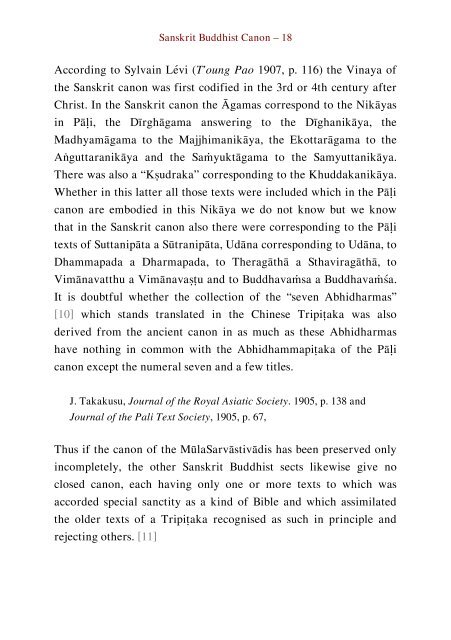Literary History of Sanskrit Buddhism
A study by J. K. Nariman of Sanskrit Buddhism from the Early Buddhist Tradition up to the Mahayana texts proper.
A study by J. K. Nariman of Sanskrit Buddhism from the Early Buddhist Tradition up to the Mahayana texts proper.
You also want an ePaper? Increase the reach of your titles
YUMPU automatically turns print PDFs into web optimized ePapers that Google loves.
<strong>Sanskrit</strong> Buddhist Canon – 18<br />
According to Sylvain Lévi (T’oung Pao 1907, p. 116) the Vinaya <strong>of</strong><br />
the <strong>Sanskrit</strong> canon was first codified in the 3rd or 4th century after<br />
Christ. In the <strong>Sanskrit</strong> canon the Āgamas correspond to the Nikāyas<br />
in Pāḷi, the Dīrghāgama answering to the Dīghanikāya, the<br />
Madhyamāgama to the Majjhimanikāya, the Ekottarāgama to the<br />
Aṅguttaranikāya and the Saṁyuktāgama to the Samyuttanikāya.<br />
There was also a “Kṣudraka” corresponding to the Khuddakanikāya.<br />
Whether in this latter all those texts were included which in the Pāḷi<br />
canon are embodied in this Nikāya we do not know but we know<br />
that in the <strong>Sanskrit</strong> canon also there were corresponding to the Pāḷi<br />
texts <strong>of</strong> Suttanipāta a Sūtranipāta, Udāna corresponding to Udāna, to<br />
Dhammapada a Dharmapada, to Theragāthā a Sthaviragāthā, to<br />
Vimānavatthu a Vimānavaṣṭu and to Buddhavaṁsa a Buddhavaṁśa.<br />
It is doubtful whether the collection <strong>of</strong> the “seven Abhidharmas”<br />
[10] which stands translated in the Chinese Tripiṭaka was also<br />
derived from the ancient canon in as much as these Abhidharmas<br />
have nothing in common with the Abhidhammapiṭaka <strong>of</strong> the Pāḷi<br />
canon except the numeral seven and a few titles.<br />
J. Takakusu, Journal <strong>of</strong> the Royal Asiatic Society. 1905, p. 138 and<br />
Journal <strong>of</strong> the Pali Text Society, 1905, p. 67,<br />
Thus if the canon <strong>of</strong> the MūlaSarvāstivādis has been preserved only<br />
incompletely, the other <strong>Sanskrit</strong> Buddhist sects likewise give no<br />
closed canon, each having only one or more texts to which was<br />
accorded special sanctity as a kind <strong>of</strong> Bible and which assimilated<br />
the older texts <strong>of</strong> a Tripiṭaka recognised as such in principle and<br />
rejecting others. [11]


















